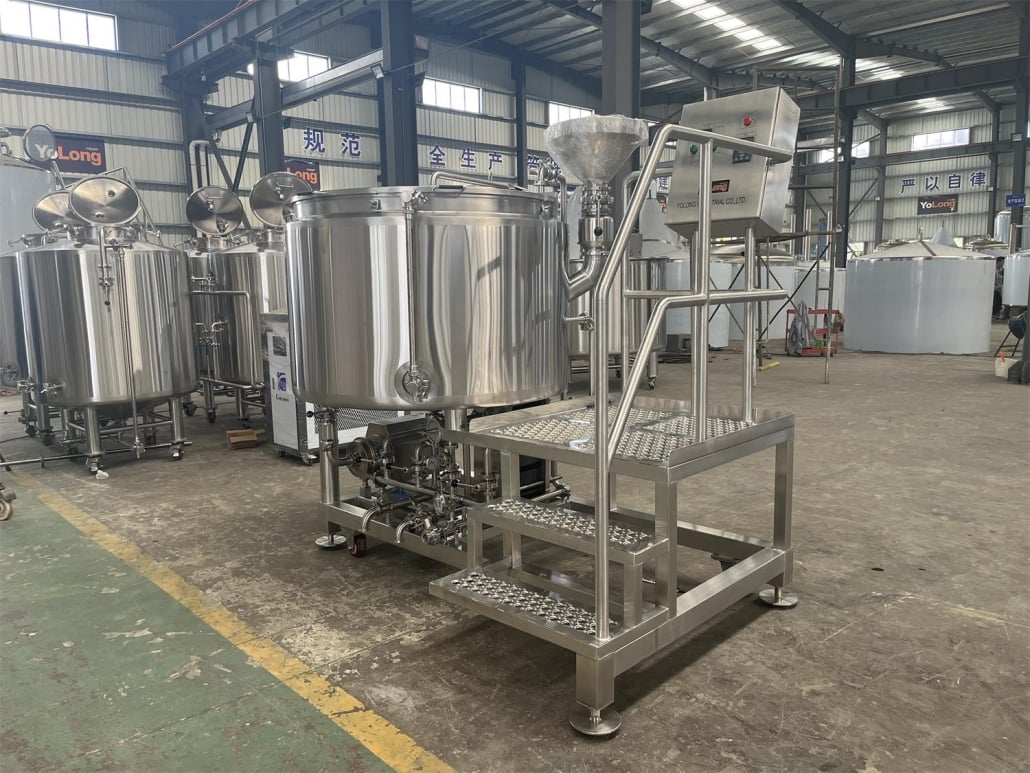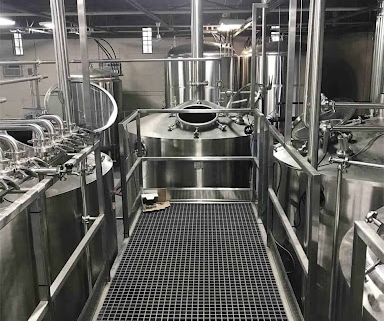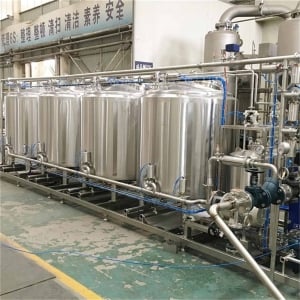Stainless Steel Brewing Tanks
Brewing beer is as much an art as it is a science, and choosing the right equipment plays a crucial role in ensuring the perfect batch every time. One of the most critical elements of any brewing system is the brewing tank. Among the various materials available, stainless steel brewing tanks have emerged as the gold standard in the industry. But why are they so popular, and what should you know before purchasing one? This comprehensive guide will walk you through everything there is to know about stainless steel brewing tanks, from their design and advantages to their operation and maintenance.
Overview of Stainless Steel Brewing Tanks
Stainless steel brewing tanks are widely regarded as the ideal vessel for brewing beer, whether you’re a homebrewer or a large-scale commercial operation. They offer a unique combination of durability, cleanliness, and efficiency, making them essential for breweries of all sizes. So, what exactly makes stainless steel brewing tanks so special?
Stainless steel is known for its resistance to rust, corrosion, and stains, which makes it the perfect material to store and ferment liquids for extended periods without compromising the integrity of the brew. These tanks come in various shapes, sizes, and customizations to suit the needs of different brewers, from small craft breweries to massive beer production plants.
Key Features:
- Material: Stainless steel (usually 304 or 316 grades)
- Sizes: Ranging from 1 barrel to 100+ barrels
- Usage: Fermentation, conditioning, and storage
- Customization: Includes features like jacketed tanks, manways, and insulation for temperature control.

Stainless Steel Brewing Tanks Equipment Guide
Before diving deep into the brewing process or tank specifics, it’s essential to understand the different equipment options available and how they affect your brewing system. Whether you’re just starting or upgrading your setup, understanding your options will guide your investment.
Stainless steel brewing tanks can be classified based on their purpose within the brewing process. Below is a guide on some common types of brewing tanks and their respective uses:
| Equipment Type | Function | Typical Size Range | Customizable Features |
|---|---|---|---|
| Mash Tun | Converts starches in grains to fermentable sugars during the mashing process. | 1-100 barrels | False bottom, rakes, insulation |
| Fermentation Tank | Where the wort (unfermented beer) is fermented into beer. | 5-500+ barrels | Cooling jackets, top manways, pressure valves |
| Brite Tank | Used for carbonating and clarifying beer before packaging. | 5-200 barrels | Internal/external cooling, sight glasses |
| Hot Liquor Tank (HLT) | Stores hot water used in brewing and mashing processes. | 1-100 barrels | Insulation, heating elements |
| Cold Liquor Tank (CLT) | Stores cold water used for chilling wort or cooling other tanks. | 5-200 barrels | Chillers, external insulation |
| Kettle | Boils wort to extract flavors from hops and sterilize the brew. | 1-100 barrels | Heating jackets, steam-powered options |
Understanding the Brewing Process in Stainless Steel Tanks
Now that we’ve touched on the different types of brewing tanks, let’s explore the brewing process and how stainless steel tanks fit into the equation.
1. Mashing:
The brewing process starts in the mash tun, where ground malt is mixed with hot water. The goal here is to convert the starches from the grains into fermentable sugars. The quality of the mash tun directly impacts the efficiency of this conversion. Stainless steel mash tuns are excellent because they maintain even heating without reacting with the ingredients.
2. Boiling:
Once mashing is complete, the liquid (called wort) is transferred to the brewing kettle. The wort is boiled with hops for flavoring and sterilization. A stainless steel kettle ensures there’s no contamination from rust or corrosion, which could ruin the beer.
3. Fermentation:
The wort is then moved to a fermentation tank, where yeast is added to convert sugars into alcohol. Fermentation can take anywhere from a few days to a few weeks, and temperature control is crucial during this phase. Stainless steel fermentation tanks are often jacketed to allow easy regulation of temperature, ensuring the yeast works its magic efficiently.
4. Conditioning:
After fermentation, the beer is usually transferred to a brite tank for carbonation and clarification. Stainless steel brite tanks are ideal for this step due to their ability to hold pressure and allow precise carbonation levels.
5. Packaging:
Finally, once the beer has been conditioned and is ready, it’s either bottled or kegged. Stainless steel helps maintain the beer’s quality until it reaches the consumer.
Design, Capacity, and Layout Considerations for Brewing Tanks
When choosing brewing tanks, it’s crucial to understand how different factors like capacity, layout, and design impact your brewing operation. Below is a breakdown of these critical aspects:
| Parameter | Details |
|---|---|
| Capacity | Tanks range from 1 barrel (31 gallons) to 500+ barrels, depending on production needs. Custom sizes available. |
| Space Considerations | Compact designs are available for small breweries, while large systems need more space for proper tank installation. |
| Design | Cylindrical, conical, or custom designs available. Common features include jacketed tanks and removable manways. |
| Layout | Tanks can be placed horizontally or vertically, depending on space constraints and brewing processes. |
| Customization | You can add features like sight glasses, rakes, temperature controls, and insulation for more precise brewing control. |
The design of your brewing system must accommodate your space and capacity needs while maintaining flexibility for growth. It’s important to plan the layout of your tanks to maximize space and efficiency in your brewery.
Suppliers and Price Range of Stainless Steel Brewing Tanks
There’s a wide range of manufacturers offering stainless steel brewing tanks, each with different pricing based on customization, capacity, and additional features. Here’s a general overview of some well-known suppliers and their price ranges.
| Supplier | Price Range (Approx.) | Details |
|---|---|---|
| Ss Brewtech | $2,000 – $50,000 | Popular with both homebrewers and small craft breweries. Known for mid-sized fermentation tanks. |
| Blichmann Engineering | $1,500 – $30,000 | Specializes in small to medium-sized brewing tanks, ideal for nano-breweries and home setups. |
| JV Northwest | $10,000 – $100,000+ | Offers custom stainless steel tanks for large commercial breweries. |
| Custom Metalcraft | $8,000 – $80,000 | Known for creating custom fermentation and conditioning tanks for commercial operations. |
| Cedarstone Industry | $5,000 – $120,000 | Provides full brewing systems, including mash tuns, fermentation tanks, and brite tanks. |
Prices vary depending on the type of tank, size, and any additional features, such as insulation or heating jackets. Custom designs generally cost more but offer a better fit for your specific brewing needs.
Installation, Operation, and Maintenance of Stainless Steel Brewing Tanks
A significant part of owning stainless steel brewing tanks is understanding how to install, operate, and maintain them. This can have a massive impact on the lifespan of your equipment and the quality of your beer.
| Step | Details |
|---|---|
| Installation | Professional installation is highly recommended, especially for larger brewing systems. Proper alignment and positioning are critical for safety. |
| Operation | Stainless steel tanks are easy to operate but may require training for features like pressure control, temperature regulation, and CO2 injection. |
| Maintenance | Regular cleaning and sanitization are essential to prevent contamination. Stainless steel requires minimal maintenance but should be descaled regularly. |
| Cleaning | Clean-in-place (CIP) systems are common in stainless steel tanks, making it easy to clean without disassembling the tanks. |
Operating and maintaining stainless steel brewing tanks can be relatively simple, especially with automated features like CIP systems. However, routine inspections are crucial for ensuring no faults develop over time.
How to Choose the Right Supplier for Stainless Steel Brewing Tanks
Choosing a supplier is as important as choosing the right tank itself. The right supplier will guide you through every step, from the initial design to installation. When evaluating suppliers, consider these factors:
| Factor | Details |
|---|---|
| Experience | Choose a supplier with experience in the brewing industry. They will be better equipped to understand your specific needs. |
| Customization Options | Look for suppliers who offer a range of customizations to ensure your tanks meet your exact specifications. |
| Pricing | Compare pricing among suppliers, but don’t just choose the cheapest. Consider the quality of materials and any additional services (like installation) they provide. |
| Warranty and Support | Ensure that your supplier offers a warranty and post-installation support. This could be critical if you run into issues with your equipment. |
| Customer Reviews | Check reviews and testimonials to gauge the satisfaction of past customers. Reliable suppliers will have a history of satisfied clients. |
When choosing a supplier, keep in mind that quality often comes with a higher price tag, but it’s worth the investment for equipment that will last decades.
Advantages and Limitations of Stainless Steel Brewing Tanks
Like any material, stainless steel has its pros and cons when it comes to brewing tanks.
| Advantages | Limitations |
|---|---|
| Durability: Stainless steel is resistant to rust and corrosion, making it incredibly long-lasting. | Cost: Stainless steel tanks tend to be more expensive than tanks made from other materials. |
| Sanitization: The smooth surface of stainless steel is easy to clean and sterilize. | Weight: Stainless steel tanks can be quite heavy, especially larger ones, making installation tricky. |
| Temperature Control: Stainless steel tanks are excellent for integrating cooling jackets and insulation. | Customization Lead Time: Custom stainless steel tanks can take longer to manufacture. |
| Non-reactive: Stainless steel doesn’t react with the ingredients, ensuring the purity of your brew. | Maintenance: While minimal, maintenance such as regular descaling is still necessary. |
The advantages far outweigh the limitations, which is why stainless steel remains the top choice for brewing tanks across the globe.

FAQ
| Question | Answer |
|---|---|
| Why are stainless steel tanks preferred in brewing? | Stainless steel tanks offer unmatched durability, are easy to clean, and don’t react with the ingredients, ensuring the purity of the beer. |
| How long does a stainless steel brewing tank last? | With proper maintenance, stainless steel tanks can last for several decades, making them a worthwhile investment. |
| Can stainless steel brewing tanks be customized? | Yes, most manufacturers offer a range of customizations, including tank size, shape, cooling options, and manways. |
| Are stainless steel brewing tanks easy to clean? | Absolutely. Many stainless steel tanks come equipped with CIP (clean-in-place) systems, making cleaning simple and efficient without the need for disassembly. |
| What’s the difference between 304 and 316 stainless steel? | 316 stainless steel contains molybdenum, which makes it more resistant to corrosion, particularly in harsh environments, compared to 304 stainless steel. |
Conclusion
Stainless steel brewing tanks are an indispensable component of any successful brewery. Their durability, ease of maintenance, and non-reactive nature make them the ideal choice for both small-scale and commercial operations. While the initial investment may be higher than other materials, the long-term benefits—such as longevity and superior brewing performance—make stainless steel the gold standard in brewing equipment. Whether you’re a homebrewer just starting out or a seasoned brewer expanding your operation, stainless steel brewing tanks will serve you well for years to come.













